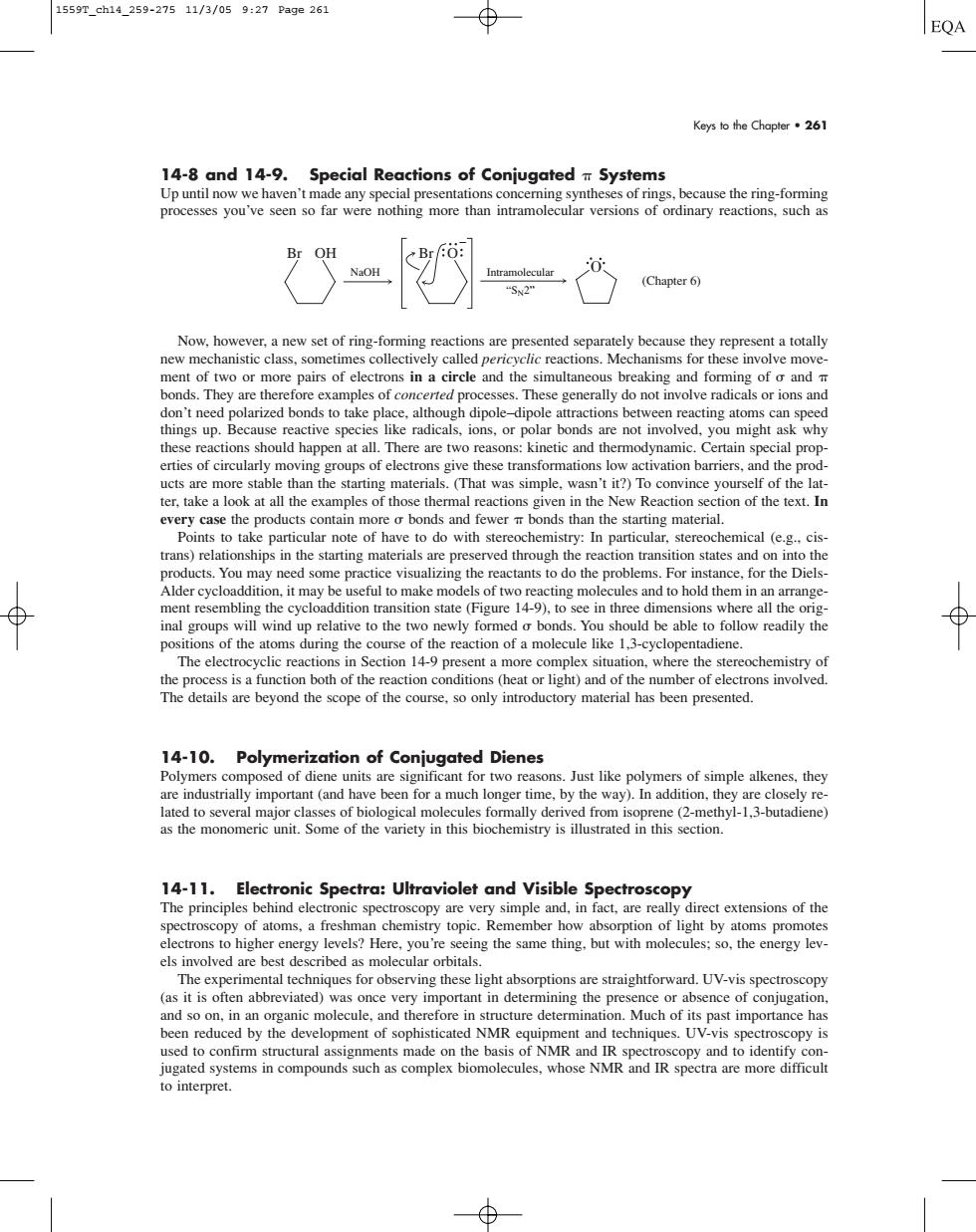正在加载图片...

1559T_ch14_259-27511/3/059:27Pa9e261 EQA Keys ohe Chapter·261 Special Reactions of Conjugated Systems =学8 ately hecause the ment of two or more pairs of electrons in a circle and the simultaneous breaking and forming of and or ions an hings up.Be cause reactive spec polar bondsare not involved,you mightask why here are two reasons: n ha ra special prop uctsar more the starting materials.(That was simplewasn't it?To co yourself of the a ter.take alook at all the of those thermal reactions given in the New Reaction io of the ev Points to take particular note of have to do with stereochemistry:In particular.stereochemical (e..cis- trans)relationships in the starting materials are preserved through the reaction transition states and on into the may nee 050 ems.For instance,for the Diels sions where all the orig inal groups nd up re eto the two ble to follow readily the The in Section 14-9present a more comple situation.where the stereochemistry of 10Po erization of Coniugated Dienes ncomposed of dicnc unitsar sifcbytheayion they are closelyre 14-11.Electronic Spectra:Ultraviolet and Visible Spectroscopy rect extensions of the els involved are best described as molecular orbita and soon in an organic and therefore in structure determination.Much of its past importance has by the developm ecnniques.Ov-v jugated systems in compounds such as compe biomolecu whose NMRand IR spectra are more diffcul to interpret. Keys to the Chapter • 261 14-8 and 14-9. Special Reactions of Conjugated Systems Up until now we haven’t made any special presentations concerning syntheses of rings, because the ring-forming processes you’ve seen so far were nothing more than intramolecular versions of ordinary reactions, such as Now, however, a new set of ring-forming reactions are presented separately because they represent a totally new mechanistic class, sometimes collectively called pericyclic reactions. Mechanisms for these involve movement of two or more pairs of electrons in a circle and the simultaneous breaking and forming of and bonds. They are therefore examples of concerted processes. These generally do not involve radicals or ions and don’t need polarized bonds to take place, although dipole–dipole attractions between reacting atoms can speed things up. Because reactive species like radicals, ions, or polar bonds are not involved, you might ask why these reactions should happen at all. There are two reasons: kinetic and thermodynamic. Certain special properties of circularly moving groups of electrons give these transformations low activation barriers, and the products are more stable than the starting materials. (That was simple, wasn’t it?) To convince yourself of the latter, take a look at all the examples of those thermal reactions given in the New Reaction section of the text. In every case the products contain more bonds and fewer bonds than the starting material. Points to take particular note of have to do with stereochemistry: In particular, stereochemical (e.g., cistrans) relationships in the starting materials are preserved through the reaction transition states and on into the products. You may need some practice visualizing the reactants to do the problems. For instance, for the DielsAlder cycloaddition, it may be useful to make models of two reacting molecules and to hold them in an arrangement resembling the cycloaddition transition state (Figure 14-9), to see in three dimensions where all the original groups will wind up relative to the two newly formed bonds. You should be able to follow readily the positions of the atoms during the course of the reaction of a molecule like 1,3-cyclopentadiene. The electrocyclic reactions in Section 14-9 present a more complex situation, where the stereochemistry of the process is a function both of the reaction conditions (heat or light) and of the number of electrons involved. The details are beyond the scope of the course, so only introductory material has been presented. 14-10. Polymerization of Conjugated Dienes Polymers composed of diene units are significant for two reasons. Just like polymers of simple alkenes, they are industrially important (and have been for a much longer time, by the way). In addition, they are closely related to several major classes of biological molecules formally derived from isoprene (2-methyl-1,3-butadiene) as the monomeric unit. Some of the variety in this biochemistry is illustrated in this section. 14-11. Electronic Spectra: Ultraviolet and Visible Spectroscopy The principles behind electronic spectroscopy are very simple and, in fact, are really direct extensions of the spectroscopy of atoms, a freshman chemistry topic. Remember how absorption of light by atoms promotes electrons to higher energy levels? Here, you’re seeing the same thing, but with molecules; so, the energy levels involved are best described as molecular orbitals. The experimental techniques for observing these light absorptions are straightforward. UV-vis spectroscopy (as it is often abbreviated) was once very important in determining the presence or absence of conjugation, and so on, in an organic molecule, and therefore in structure determination. Much of its past importance has been reduced by the development of sophisticated NMR equipment and techniques. UV-vis spectroscopy is used to confirm structural assignments made on the basis of NMR and IR spectroscopy and to identify conjugated systems in compounds such as complex biomolecules, whose NMR and IR spectra are more difficult to interpret. NaOH Intramolecular “SN2” Br OH Br O (Chapter 6) 1559T_ch14_259-275 11/3/05 9:27 Page 261